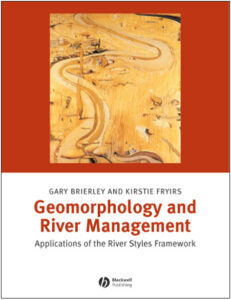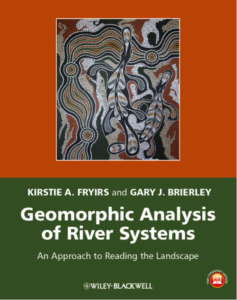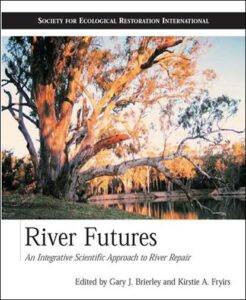Textbooks
Geomorphology and River Management

Geomorphology and River Management: Applications of the River Styles Framework. Blackwell Publishing, Oxford, UK, 398pp.
ISBN 1-4051-1516-5 Link Visit publisher’s website
Back cover text
Rivers show a remarkable diversity of river character and behaviour in any catchment. Human activities, whether purposeful or otherwise have impacted profoundly on the inherent variability in patterns and rates of river adjustment, altering what rivers look like and how they behave, and the structure and function of aquatic ecosystems. This book outlines a generic set of procedures, termed the River Styles framework that provides a set of tools for interpreting river character, behaviour, condition and recovery potential.
River management programs that ‘work with nature’ must respect the inherent diversity and behavioural regime of aquatic ecosystems. Each catchment is managed in its own right, recognizing the patterns and connectivity of river forms and processes, as shaped by the configuration of the system and responses to disturbance events. Applications of the River Styles framework generate a coherent package of geomorphic information, providing a physical template for river rehabilitation activities. This book will suit a wide range of river practitioners, including students, technical officers, consultants and academics.
Reviews
“Clearly the audiences for this book are students taking a course in river management; they will find everything they need in it. The book is up-to-date, clearly written and the quality (photographs, figures and layout) is good.” – Journal of Sedimentary Research, 2005
“This book is a very useful addition to existing literature on river forms and processes within the context of river management. The introduction provides a geomorphic perspective on river restoration and introduces the “river styles” framework, a set of procedural guidelines for documenting and appraising rivers. The first two chapters on spatial and temporal considerations focus on physical processes and descriptors as these relate to river ecology. The next four chapters continue to explore river geomorphology, emphasizing river character, behavior, change, and responses to human disturbance. The final six chapters of the book provide details on how to use the river styles framework, with the Bega catchment of southeastern Australia as an example. The book concludes with an extensive reference list and a thorough and useful index. I highly recommend this book to anyone interested in rivers as well as river management. The text is clearly written and is easily understandable to nonspecialists and to researchers in disciplines outside fluvial geomorphology, but it also provides an excellent overview of fluvial geomorphology suitable for use as a textbook in upper-level undergraduate and graduate courses. The authors have effectively integrated an extraordinary range of information, and the numerous beautiful illustrations enhance and complement the text. The authors emphasize the importance of three key points throughout the text: understanding river processes, addressing processes within a catchment context, and recognizing that rivers are dynamic landscapes that are constantly changing across a variety of spatial and temporal scales. In this context, the book forms part of the (delayed) response to current simplistic approaches to river management by the fluvial geomorphic research community. Much of the river restoration presently undertaken has an extremely small spatial and short temporal focus and assumes that a segment of river can be restored by engineering a fixed form. The river styles framework advocated in this book is neither simple nor easy in comparison to current river engineering, but it should not be; the currently widespread failure to recognize the complexity of river dynamics has resulted in many failed restoration projects.” – Ellen Wohl, Department of Geoscience, Colorado University
“River lovers and anyone else interested in handson river system management will find the new Brierley and Fryirs book an interesting and useful read. The book, organized into three large sections, begins by taking a quick but lavishly illustrated look at the basics of fluvial geomorphology, emphasizing both basic concepts of spatial organization and the processes involved in temporal change. The second and largest section of the book delves more deeply into the details of both topics. It would, by itself, make a very nice supplemental text for use in river restoration or fluvial ecology courses. Overall, readers interested in restoration issues, river science, and of course geomorphology, will find “Geomorphology and River Management: Applications of the River Styles Framework” a useful reference work. The combination of comprehensive review of principals (Parts A and B) with an explicit methods primer and case study (Part C) undoubtedly makes this a powerful training document for those directly interested in understanding or implementing the Rivers Styles approach. At the same time, this combination of generality and specific methodology makes the book a less obvious choice for use in university courses and workshops. For readers interested in riverine wetlands, Brierley and Fryirs’ new book provides a lot of useful background but little integration of geomorphology with fluvial ecology.” – Michael J Wiley, School of Natural Resources and Environment, University of Michigan, in WETLANDS vol. 26 no. 3, September 2006, pp. 884-885.
“The main focus of this text is the river styles framework (RSF), a geomorphic approach developed by the authors (see also Fryirs, 2001) for assessing the condition and recovery potential of rivers. The basis for the approach is the recognition that “(I)nformation on the diversity and abundance of river types, their condition, and associated ecological values provides a critical starting point for management activities in any given catchment or region” (p. 51). The text, which has a very clear structure and layout, is well written and has excellent illustrations throughout, provides a clear argument for the need to “appraise each field situation separately, viewed within its catchment context and evolutionary history”. It is a timely contribution to the literature and should be essential reading for all those with an interest in the science and practice of river management and river restoration. Although the river styles framework has been developed in Australia, it is presented as a generic research and management tool and the test of RSF will therefore be its global uptake and successful application to different river systems.” – Geraldene Wharton, Queen Mary University, London
“Peoples’ attitude to the environment has evolved as society has matured. Over the past 150 yr our use of the environment has moved along a continuum; from colonisation, through resource exploitation, to environmental stewardship. The Resource Management Act has further encouraged analysis of, and reflection upon, our effects on the environment. Water is a fundamental consideration, either directly or indirectly, to almost all resource decision-making. It would appear opportune, therefore, that Geomorphology and river management – applications of the River Styles Framework has been published to guide our interpretation, analysis, management, and rehabilitation of rivers. Rivers exhibit a remarkable diversity of character and behaviour which is complicated further by a high degree of inherent spatial and temporal variability. This diversity has been impacted profoundly by a wide range of human activities, both intentional and unintentional, which also have strong spatial and temporal components. In combination, this creates an almost infinite range of river forms, processes, and change; with few rivers remaining in pristine condition. This presents a major challenge to land and water resource managers. Developing a meaningful framework to recognise, understand, document, and maintain this diversity is a core theme of this book. The book actually goes further arguing that “Our efforts to sustain healthy, living rivers provide a measure of societal health and our governance of the planet on which we live”. While holistic river management has become fashionable, there is little consensus as to how rivers should be managed, or even how river systems will change and evolve under particular management scenarios. Fundamental to moving forward is our ability to understand why rivers are the way they are, how they have changed, and how they are likely to look and behave in the future. This book goes a long way to overcoming this constraint. Clearly, this book will become a primer for all those interested in river dynamics and change, and rehabilitation. Its coverage of this theme is comprehensive, with the material being up to date and clearly written. The text is supported by a range of high quality, informative illustrations. While the price is perhaps a little expensive, this is offset by not having to now purchase a number of technical texts. I have already suggested that our library purchase a number of copies for student reference.” – Jack McConchie, School of Earth Sciences, Victoria University, Wellington
“This book is a welcome addition to the literature on river management. The authors ground their work in a solid knowledge of fluvial geomorphology instead of focusing on river ecology or river engineering as do many other river management texts. The book does not take the place of such texts but provides much needed geomorphic context on the root causes of river disturbance at the catchment level. The approach taken highlights the need to identify and deal with the causes of river disturbance instead of attempting only to fix the symptoms through engineering of river channels. To this end, the authors have developed a generic approach to analyzing rivers and their catchments called the River Styles framework. The River Styles framework is not a cookbook approach to river management. It provides a generic set of procedures to organize data and observations at different scales to predict the future condition of the river and its rehabilitation potential. River managers, river engineers, aquatic ecologists and fluvial geomorphologists will all benefit from reading this book.” – Leif Burge, Okangan College
Geomorphic Analysis of River Systems

Fryirs, K.A. and Brierley, G.J. (2013)
Geomorphic Analysis of River Systems: An approach to Reading the Landscape. John Wiley and Sons, Chichester, 345pp.
ISBN 978-1-4051-9274-3
Back cover text
Reading the Landscape entails making sense of what a riverscape looks like, how it work, how it has evolved over time and how alterations to one part of a catchment may have secondary consequences elsewhere, over different timeframes. These place-based field analyses are framed within their topographic, climatic and environmental context. Issues and principles presented in the first part of this book provide foundational understandings that underpin the approach to reading the landscape that is presented in the second half of the book. In reading the landscape, detective-style investigations and interpretations are tied to theoretical and conceptual principles to generate catchment-specific analyses of river character, behaviour and evolution, including responses to human disturbance.
This book has been constructed as an introductory text on river landscapes, proving a bridge and/or companion to quantitatively-framed or modelled approaches to landscape analysis that are addressed elsewhere. Key principles outlined in the book emphasise the importance of complexity, contingency and emergence in interpreting the character, behaviour and evolution of any given system.
The target audience is second and third year undergraduate students in geomorphology, hydrology, earth science and environmental science, as well as river practitioners who use geomorphic understandings to guide scientific and/or management applications.
Reviews
“I believe the authors have excellent material for this a very interesting and compelling book that will far exceed anything currently available to undergraduate students. I wish the book had been produced years ago.”
“This book should equip students with the ability to read the landscape is an excellent one.”
“They are committed teachers who excel at their professions and would have long been aware of the gap in the market in this respect.”
“The strengths [of this book] are that it will be an up-to-date, field-based volume aimed at an under-served audience of undergraduates and field practitioners. Also, this volume would be written by researchers who are very knowledgeable about rivers and are skilled in communication.”
“Clearly, this book will become a primer for those interested in river dynamics and change, and rehabilitation.”
River Futures: An Integrative Scientific Approach to River Repair

Brierley, G.J. and Fryirs, K.A. (Eds.) (2008)
River Futures: An Integrative Scientific Approach to River Repair. Island Press, Washington DC
ISBN 9781597261128
Case studies explore practical applications in different parts of the world, highlighting approaches to the use of integrative river science, measures of success, and steps that could be taken to improve performance in future efforts.
River Futures offers a positive, practical, and constructive focus that directly addresses the major challenge of a new era of river conservation and rehabilitation—that of bringing together the diverse and typically discipline-bound sets of knowledge and practices that are involved in repairing rivers. It is a valuable resource for anyone involved in river restoration and management, including restorationists, scientists, managers, and policymakers, as well as undergraduate and graduate students.
Back cover text
Across much of the industrialized world, rivers that were physically transformed and ecologically ruined to facilitate industrial and agricultural development are now the focus of restoration and rehabilitation efforts. River Futures discusses the emergence of this new era of river repair and documents a comprehensive biophysical framework for river science and management.
The book considers what can be done to maximize prospects for improving river health while maintaining or enhancing the provision of ecosystem services over the next fifty to one-hundred years. It provides a holistic overview of considerations that underpin the use of science in river management emphasizing cross-disciplinary understanding that builds on a landscape template.
Reviews
“River Futures offers a comprehensive overview of the state of our knowledge about river rehabilitation. Like early explorers’ maps, it also sketches the shape of rich terrain waiting to be explored more thoroughly, where human values and needs are deeply interwoven into the process of river repair. This book is essential cargo for anyone wanting to understand where we’ve been, and where we need to go.” – Brian Richter, Director, Global Freshwater Program, The Nature Conservancy
“What a delight to have a book that provides the theoretical foundation for the next half-century of toil as we strive to repair our rivers. A central message of River Futures is that much of that toil is the exhausting business of integrating within and between science and society. This book is required reading for anyone devoted to leaving our rivers better than they found them.” – Ian Rutherfurd, Professor, Department of Natural Resources and Geography, University of Melbourne
“This book provides a considered and authoritative foundation for the move away from simple habitat structures and engineering mimicry to the much-needed fundamental reassessment of ecological integrity in rivers and their catchments. The authors convincingly discuss and evaluate evidence-based remedial strategies and operations in a diverse international set of case studies. If only Aldo and Luna Leopold could see how far we’ve come!” – Malcolm Newsom, Professor of Physical Geography, School of Geography, Politics and Sociology, Newcastle University, London

